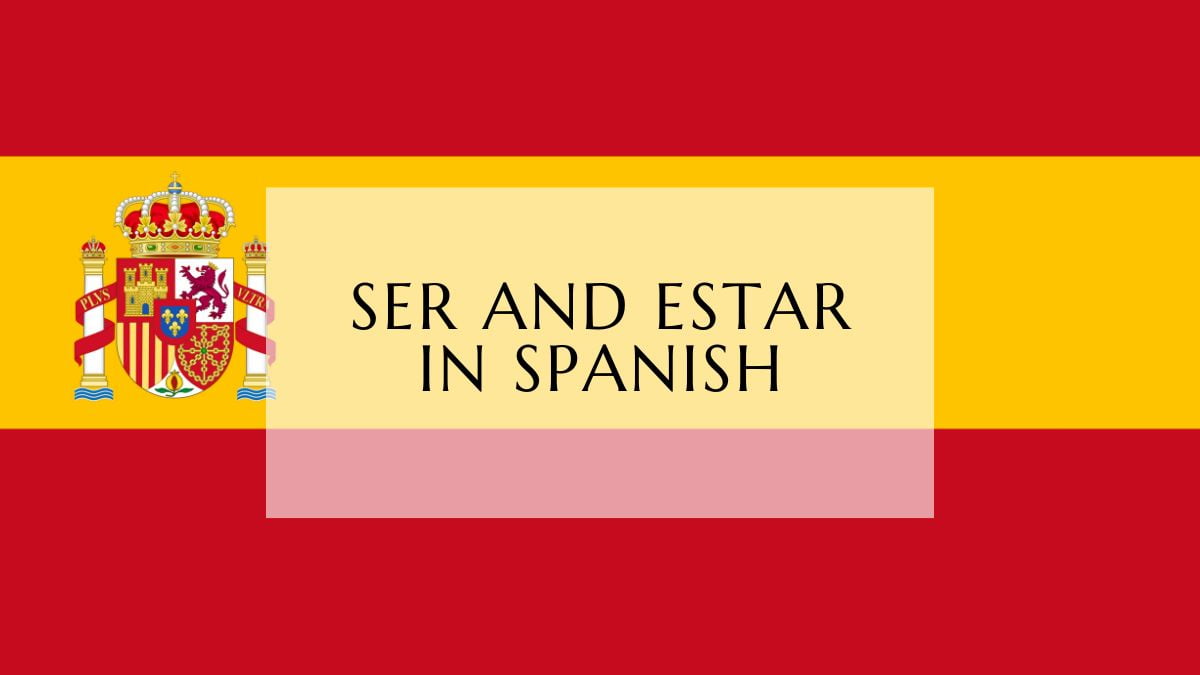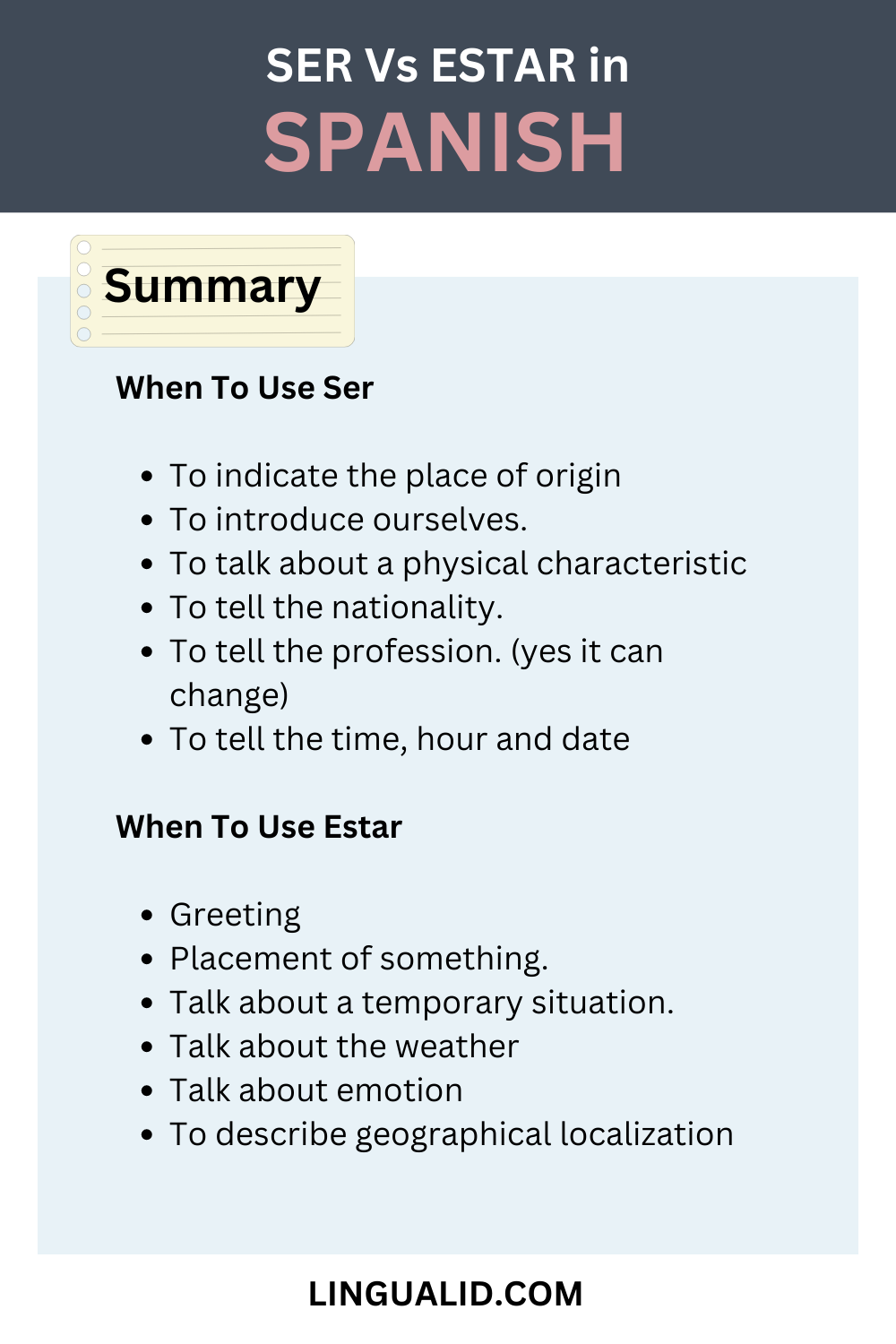In this lesson, we will talk about Ser and Estar in Spanish, their conjugations and when to use each one of them. And some examples to clear any confusion.

In Spanish, we have two verbs to express the English verb “to be”: Ser and Estar, each one has its own usage, before explaining each one, let’s get their present conjugation right first:
| Pronoun | Ser | Estar |
| Yo | soy | estoy |
| Tú | eres | estás |
| Él/ ella | es | está |
| Usted | es | está |
| Nosotros / Nosotras | somos | estamos |
| Vosotros / Vosotras | sois | estáis |
| Ellos / Ellas | son | están |
| Ustedes | son | están |
When to use “ser” and “estar” In Spanish
In general, the verb “Ser” is used for permanent (or long lasting) situations, while the verb “Estar” is used for more temporary situations (like conditions, locations, emotions).

When To Use Ser
- To indicate the place of origin
- To introduce ourselves.
- To talk about a physical characteristic
- To tell the nationality.
- To tell the profession. (yes it can change)
- To tell the time, hour and date
Note: you can practice what you’ve learned here, and learn how to pronounce each of the words in our Memrise course here, don’t know how to use the platform or sign up? we’ve got you covered in this easy-to-follow tutorial here.
When To Use Estar
- Greeting
- Placement of something.
- Talk about a temporary situation.
- Talk about the weather
- Talk about emotion
- To describe geographical localization
There are some situations where the meaning changes depending on the verb used:
Estoy listo (I’m ready) – Soy listo (I’m clever)
Soy de Marruecos (I’m from Morocco) – Estoy en Marruecos (I’m in Morocco)
Your origin is a permanent situation, but being in a place is temporary.
Carlos está serio (it’s a current mood that will change)
Carlos es serio (we are describing a characteristic of his personality)
What about beauty, is it permanent or it is because of the clothes or makeup for example:
Ella es guapa (describing her appearance: she is pretty)
Ella está guapa con ese vestido (at this specific moment : she is looking pretty in that dress)
Ser vs. Estar: A Review
Glossary of Key Terms
- Ser: The Spanish verb “to be” used for permanent or long-lasting situations.
- Estar: The Spanish verb “to be” used for temporary situations, locations, and conditions.
- Permanent Situation: A state of being that is unchanging or unlikely to change (e.g., nationality, personality).
- Temporary Situation: A state of being that is subject to change (e.g., mood, location, weather).
- Physical Characteristic: A defining feature of someone’s appearance (e.g., hair color, height).
- Personality Trait: An enduring aspect of someone’s character (e.g., serious, funny).
- Geographical Localization: The specific location of something or someone.
Questions
Instructions: Answer each question in 2-3 sentences.
- What is the main difference between “ser” and “estar”?
- Provide two examples of when you would use “ser” in a sentence.
- Provide two examples of when you would use “estar” in a sentence.
- How would you describe someone’s origin using “ser”?
- How would you describe someone’s current location using “estar”?
- What is the difference in meaning between “Estoy listo” and “Soy listo”?
- How would you describe someone as being inherently funny using “ser”?
- How would you describe someone as looking happy today using “estar”?
- If you want to say you are from Argentina, would you use “ser” or “estar”?
- If you want to say you are currently in Spain, would you use “ser” or “estar”?
Short Answer Key
- “Ser” is used for permanent or long-lasting situations, while “estar” is used for temporary situations, locations, conditions, and emotions.
- Example 1: Soy alto (I am tall). Example 2: Ella es médica (She is a doctor).
- Example 1: Estoy feliz (I am happy). Example 2: El libro está en la mesa (The book is on the table).
- You would use “ser” with the preposition “de” to indicate origin. For example, Soy de México (I am from Mexico).
- You would use “estar” with the preposition “en” to indicate current location. For example, Estoy en la biblioteca (I am at the library).
- “Estoy listo” means “I am ready” (a temporary state), while “Soy listo” means “I am clever/smart” (a permanent characteristic).
- You would say, “Él es cómico/gracioso” (He is funny).
- You would say, “Ella está feliz hoy” (She is happy today).
- You would use “ser” because origin is a permanent characteristic. You would say, “Soy de Argentina.”
- You would use “estar” because your current location is a temporary state. You would say, “Estoy en España.”
Happy learning!
Oualid Cheddadi is the founder of Lingualid, a platform that inspires independent language learners worldwide, regardless of the language they are learning. The name “Lingualid” is derived from the Portuguese word for “language,” “língua,” and the last three letters of Oualid’s name, “Lid.”



